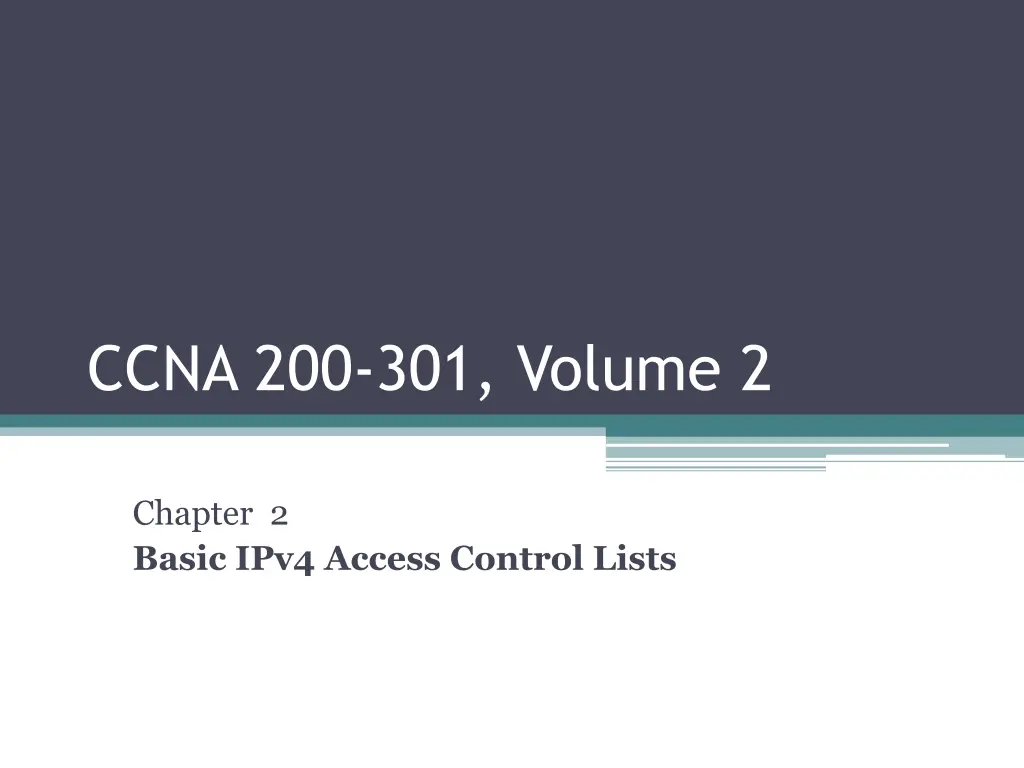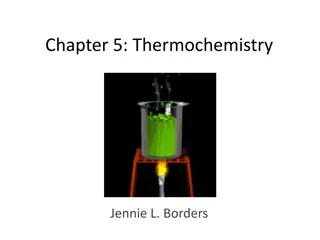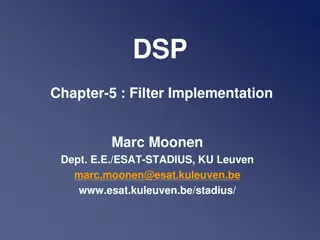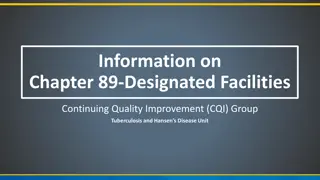
IPv4 Access Control Lists Configuration and Implementation Guide
Learn how to configure and verify IPv4 access control lists (ACLs) to filter and manage network traffic effectively. Understand the basics of IPv4 ACLs, different ACL types, filtering packets, matching logic, wildcard masks, and more. Enhance your Cisco router skills with practical examples and insights on ACL command syntax and usage.
Download Presentation

Please find below an Image/Link to download the presentation.
The content on the website is provided AS IS for your information and personal use only. It may not be sold, licensed, or shared on other websites without obtaining consent from the author. If you encounter any issues during the download, it is possible that the publisher has removed the file from their server.
You are allowed to download the files provided on this website for personal or commercial use, subject to the condition that they are used lawfully. All files are the property of their respective owners.
The content on the website is provided AS IS for your information and personal use only. It may not be sold, licensed, or shared on other websites without obtaining consent from the author.
E N D
Presentation Transcript
CCNA 200-301, Volume 2 Chapter 2 Basic IPv4 Access Control Lists
Objectives Configure and verify access control lists
IPv4 Access Control List Basics IPv4 access control lists give network engineers a way to identify different types of packets. ACL configurations list values that the router can see in the IP, ICMP, TCP, and UDP (and other) headers. IPv4 ACLs perform many functions in Cisco routers, including packet filtering and QoS.
Locations to Filter Packets from Hosts A and B Going Toward Server S1
Pseudocode to Demonstrate ACL Command-Matching Logic
Backdrop for Discussion of List Process with IP ACLs
ACL Items Compared for Packets from Hosts A, B, and C on Previous Slide
Logic for WC Masks 0.0.0.255, 0.0.255.255, and 0.255.255.255
Syntactically Correct ACL Replaces Pseudocode
Binary Wildcard Mask Example For subnet 172.16.8.0 255.255.252.0, use the subnet number as the address parameter and do the following math to find the wildcard mask:
Matching Any/All Addresses In some cases, one ACL command can be used to match any and all packets that reach that point in the ACL using the any keyword. Example: access-list 1 permit any. All Cisco IP ACLs end with an implicit deny any.
Implementing Standard IP ACLs Step 1: Plan the location and direction on that interface Step 2: Configuration one or more access-list global configuration commands to create the ACL Step 3: Enable the ACL on the chosen router interface, in the correct direction, using the ip access-group number {in | out} interface subcommand.
Standard Numbered ACL Example 1 Configuration
Creating Log Messages for ACL Statistics
Example of Checking the Interface and Direction for an ACL
Building One-Line Standard ACLs: Practice Problem Criteria 1 Packets from 172.16.5.4 2 Packets from hosts with 192.168.6 as the first three octets 3 Packets from hosts with 192.168 as the first two octets 4 Packets from any host 5 Packets from subnet 10.1.200.0/21 6 Packets from subnet 10.1.200.0/27 7 Packets from subnet 172.20.112.0/23 8 Packets from subnet 172.20.112.0/26 9 Packets from subnet 192.168.9.64/28 10 Packets from subnet 192.168.9.64/30
Reverse Engineering from ACL to Address Range With the command access-list 1 permit 172.16.200.0 0.0.7.255, the low end of the range is 172.16.200.0. To find the high end of the range, add this number to the WC mask, as shown here:
Finding IP Addresses/Ranges Matching by Existing ACLs Problem Criteria 1 access-list 1 permit 10.7.6.5 2 access-list 2 permit 192.168.4.0 0.0.0.127 3 access-list 3 permit 192.168.6.0 0.0.0.31 4 access-list 4 permit 172.30.96.0 0.0.3.255 5 access-list 5 permit 172.30.96.0 0.0.0.63 6 access-list 6 permit 10.1.192.0 0.0.0.31 7 access-list 7 permit 10.1.192.0 0.0.1.255 8 access-list 8 permit 10.1.192.0 0.0.63.255
IOS Changing the Address Field in an access-list Command






















